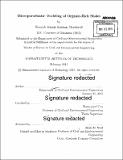Microporoelastic modeling of organic-rich shales
Author(s)
Khosh Sokhan Monfared, Siavash
DownloadFull printable version (11.32Mb)
Other Contributors
Massachusetts Institute of Technology. Department of Civil and Environmental Engineering.
Advisor
Franz-Josef Ulm.
Terms of use
Metadata
Show full item recordAbstract
Due to their abundance, organic-rich shales are playing a critical role in re-defining the world's energy landscape leading to shifts in global geopolitics. However, technical challenges and environmental concerns continue to contribute to the slow growth of organic-rich shale exploration and exploitation worldwide. The engineering and scientific challenges arise from the extremely heterogeneous and anisotropic nature of these naturally occurring geo-composites at multiple length scales. Specifically, the anisotropic poroelastic behavior of organic-rich shales becomes of critical importance for petroleum engineers. Thus, the focus of this thesis is to capture mechanisms of first-order contribution to the effective anisotropic poroelasticity of organic-rich shales which can pave the way for more efficient and effective exploration and exploitation. We introduce an original approach for micromechanical modeling of organic-rich shales which accounts for the effect of organic maturity on the overall anisotropic poroelasticity through morphology considerations. This morphology contribution is captured by means of an effective media theory that bridges the gap between immature and mature systems through the choice of the system's micro-texture; namely a matrix-inclusion morphology (Mori-Tanaka) for immature systems and a polycrystal/ granular morphology for mature systems. Also, we show that interfaces play a role on the effective elasticity of mature organic-rich shales. The models are calibrated by means of ultrasonic pulse velocity measurements of elastic properties and validated by means of lab measured nanoindentation data. Sensitivity analyses using Spearman's Partial Rank Correlation Coefficient show the importance of porosity and Total Organic Carbon (TOC) as key input parameters for accurate model predictions. These models' developments provide a mean to define a "unique" set of clay elasticity. They also highlight the importance of the depositional environment, burial and diagenetic processes on overall mechanical and poromechanical behavior of organic-rich shales.
Description
Thesis: S.M., Massachusetts Institute of Technology, Department of Civil and Environmental Engineering, 2015. Cataloged from PDF version of thesis. Includes bibliographical references (pages 175-183).
Date issued
2015Department
Massachusetts Institute of Technology. Department of Civil and Environmental EngineeringPublisher
Massachusetts Institute of Technology
Keywords
Civil and Environmental Engineering.